4 Eyebrow-Arching Backstories Behind Famous Movies
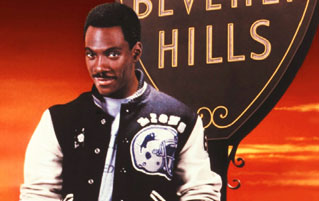
A good indicator of the level of artistic integrity that exists in Hollywood is the amount of scripts that get recycled. I don't mean stuff like "Oh, Avatar is just The Discreet Charm of the Bourgeoisie with blue people" (even though it definitely is, goddammit) -- I'm talking about when they take a random script, change all the names, and turn it into Rambo 7 or something. Or vice versa: Maybe it started as Rambo 7 and they turned it into a "new" movie with Jason Statham. The point is, they don't give a shit about the intention of the original writer, unless said intention was "make me lots of money." Which it probably was, so forget what I said.
Other Cracked columnists have already told you about how Die Hard started as a sequel to Schwarzenegger's Commando (andFrank Sinatra's The Detective), while Van Damme's Cyborg would have been a He-Man movie if not for Spider-Man. Yes, I did want to use those movies in this article before finding out they'd already been used, but no, I'm not bitter about it. Anyway, those examples are stupid and suck compared to these ones ...

John Carpenter's Dark Star ends with an astronaut surfing in space as country music plays, so yes, I think that counts as wacky. For those who haven't seen it, Dark Star is a low-budget 1974 sci-fi comedy about blue collar workers in a spaceship, and sorry for spoiling the ending just now. It's also the blueprint for Ridley Scott's Alien, and not because the plots are kinda similar -- it's because the writer of both movies, Dan O'Bannon, straight up said Alien was "Dark Star as a horror movie instead of a comedy."
In fact, there's even an early version of the monster from Alien in Dark Star. Here it is:

It went from a ball to a phallus, but then again, didn't we all at some point?
If that looks like a beach ball with claws, that's because that's literally what it is. A beach ball, two claws, and some glue were the only special effects Dark Star's budget could afford for the space monster who hides in the ship in the second act of the movie. O'Bannon and his writing partner Ronald Shusett later took that second act (and the whole thing about the blue collar workers stuck in space for a long time and occasionally being cryogenically frozen) and expanded it into a full script, also using ideas from an earlier story O'Bannon had written about gremlins causing shenanigans in a World War II plane.
However, "It's like this obscure movie I did, but scary!" is a harder pitch to sell than you might think, so O'Bannon avoided starvation by getting involved in other projects, like this thing called Star Wars and Alejandro Jodorowsky's doomed Dune adaptation. It was on Dune that O'Bannon hooked up with Swiss artist H.R. Giger, who eventually revamped the beach ball with claws into the hideous dick monster we all know and love.

Th-thank you?
But Wait, There's More:
While on the subject of Dicks: I mentioned Ron Shusett, who helped O'Bannon with the script that would become Alien. At the same time, O'Bannon was helping Shusett with a project of his own, an adaptation of a story called We Can Remember It for You Wholesale by cult (read: poor) author Philip K. Dick. It took a little longer to get this one off the ground, but it did finally come out in 1990 with a shorter title: Total Recall. Yes. That's right. The obscure original version of the Colin Farrell classic.
To further complicate matters, Total Recall itself almost had a sequel based on another Philip K. Dick story, or Dickstory, called ... Minority Report, which later got recycled into a Tom Cruise thing (the precogs were supposed to be Martian mutants). Oh, and because these people never let a single idea go to waste, O'Bannon's "gremlins in World War II" script I mentioned above ended up in the animated movie Heavy Metal, only with zombies.
So, to recap, all these movies came (at least partially) from two unknown, starving writers sitting in a room in the mid-'70s:

On the one hand, that's $2 billion. On the other, that last row. Beverly Hills Cop Could Have Been Stallone's Cobra

Trying to imagine Beverly Hills Cop without Eddie Murphy is as hard as it is pointless, since there's no way anyone would give a shit about this film if Murphy wasn't in it. Good thing we don't have to imagine that, then, because the movie did (sort of) get made again with the guy who almost played the main character instead of Murphy. Here he is:

Wha? How? When? Calm down and I'll tell you. The Beverly Hills Cop project dates back to the mid-'70s, when a Paramount executive got stopped by an officer in Hollywood and thought that was just the most hilarious thing. "A cop? Where the rich people live? What will they think of next?" The project went through several iterations, until Sylvester Stallone finally signed up to play the main character, but he had a few notes on the script, by which I mean that he rewrote the whole fucking thing. He renamed the character Axel Cobretti ("Foley" wasn't sufficiently Stallonesque), killed off Judge Reinhold's character for dramatic effect, and added D-Day levels of violence. That's his comparison, not mine.
However, only two weeks before the movie started filming, Paramount decided Stallone's script was too expensive, and Sly bailed. Eddie Murphy was brought in at the last moment, and since the script was still being hastily rewritten while the scenes were being shot, that gave him ample space to improvise his own lines, and the rest is movie magic.
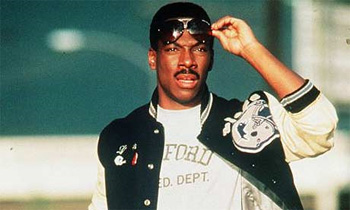
They had to remove all those references to the LA sun being bad for Axel's pale complexion.
After that, Stallone took all his ideas for the gritty version of Beverly Hills Cop and turned them into another movie called Cobra (you know, because the main dude's name is Cobretti). Since he couldn't use the "out-of-town cop moves to LA" plot anymore, he filled in the gaps by adapting a crime novel called Fair Game -- which Cinemax watchers of the '90s might recognize as the basis for that 1995 Cindy Crawford/Billy Baldwin soft-core action flick of the same name. Yes, the one with the train fucking scene. I forgot what we were talking about.
But Wait, There's More:
Oh, right. Thanks to Beverly Hills Cop's last minute change, the movie's producers, Jerry Bruckheimer and Don Simpson, accidentally ended up with a winning formula: young black cops in sunny settings shooting guns and improvising funny one-liners. When they left Paramount in the '90s, they just replaced Eddie Murphy with Will Smith and Martin Lawrence and continued cranking out sequels and making big bucks with Bad Boys. Except that, no, there's no formula, because Bad Boys was a total accident, too: It was originally written for non-black, non-young Dana Carvey and Jon Lovitz (they were both around 40).
As a consolation prize, Carvey and Lovitz did end up making a movie with Bad Boys' writer, George Gallo, called Trapped in Paradise.
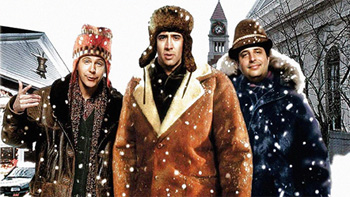
With Nicolas Cage thrown in for extra WTFs.
Here's all you need to know about this movie: Lovitz calls it " Trapped in Shit." That's the same Jon Lovitz from City Slickers II: The Legend of Curly's Gold, by the way.
Who Framed Roger Rabbit Was Almost Chinatown 3 (Maybe)

I would put this entry at #1 if I was sure it's true, but I'm not totally sold. After all, look how different these movies are: Who Framed Roger Rabbit is about a private detective investigating a simple case of infidelity who finds himself embroiled in a far-reaching conspiracy involving corruption and murder in the city of Los Angeles, and Chinatown is ... huh. Also, both protagonists 1) are jaded, hard-drinking ex cops and 2) hook up with a femme fatale, although the animated version is actually far sexier than the human one.

Just look at those ears. Goddamn.
Those similarities could be chalked up to both movies following the cliches of the detective genre, but there's another possible explanation: According to various sources, Who Framed Roger Rabbit is partly based on a proposed Chinatown sequel called Cloverleaf. Cloverleaf, if the word sounds familiar, is also the name of the transportation company that wants to destroy Toontown to build a freeway in Roger Rabbit. Just like Chinatown dealt with shady water companies and The Two Jakes (the Jack Nicholson-directed sequel) covered a natural-gas scandal, Cloverleaf would have been about the freeway system, completing Robert Towne's trilogy about corruption in Los Angeles.
But then someone added cute cartoon animals to the plot, somehow.

And this, which is more disturbing than any "she's my sister and my daughter" plot twist.
It's unclear how the hell that supposedly happened. Chinatown and Roger Rabbit are by different studios, producers, directors, writers, and even actors (the scene with Goofy in Roman Polanski's gang got cut). Also, some sources say the failure of The Two Jakes in 1990 prompted the Cloverleaf script to get recycled, but the only small problem there is that Roger Rabbit came out in 1988. And finally, Robert Towne confirmed that he wanted to do a trilogy, but said he had no idea where the name Cloverleaf came from. So I can't in good conscience tell you this story is true, but weirder things have happened in Hollywood. Honestly, all of this still sounds more feasible than the fact that this movie managed to get Bugs Bunny and Mickey Mouse in the same scene.
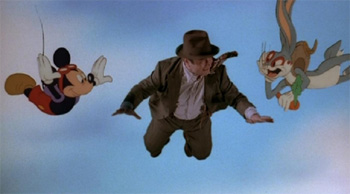
They hadn't talked to each other since Bugs gave Minnie the clap in '65.
But Wait, There's More:
Movie scripts aren't the only thing that gets recycled a lot in entertainment -- this shit happens with video games, too. In Japan, Who Framed Roger Rabbit was turned into a Nintendo game that you might know better under its U.S. release name: The Bugs Bunny Crazy Castle. Or maybe you played it on the Game Boy, where it was simply called Mickey Mouse. That's Roger Rabbit, bringing rival franchises together across media (albeit accidentally, since this was all due to a licensing rights clusterfuck). Sadly, I cannot confirm the persistent urban legend that in Poland the game came out as Jake Gittes' Wacky Palace.
Airplane! Has Been Made Four Other Times ... as a Drama

If I have one purpose in this world, that's making sure more people are aware of the fact that Airplane! is a remake of a 1957 drama called Zero Hour! (back then, an exclamation mark meant the movie was serious business). Not a spoof that vaguely resembles its source material, like Meet the Spartans or something -- an official, honest-to-goodness remake. As in, they bought the rights and all. Check out this comparison between the two movies, which has to be one of the most life-changing videos I've seen in my life:
The Zucker brothers and Jim Abrahams didn't even know that movie existed until they accidentally taped it overnight, but they found it so unintentionally hilarious that they had no choice but to option it for a remake and go through the script adding jokes to all the scenes. Or most of the scenes. Sometimes, they just left the original dialogue intact, like in this part:
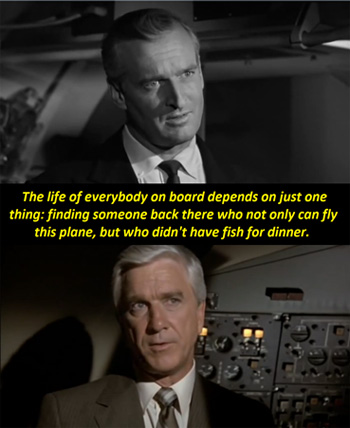
Leslie Nielsen could read any line and make it funny (except the entire script to Dracula: Dead and Loving It).
What they probably didn't know was that they weren't the first ones to remake this particular script ... or the second, or the third, or the fourth. It turns out Zero Hour! itself is a remake of an even older Canadian TV movie called Flight into Danger, starring a young Scotty from Star Trek. It's the same dang thing: A PTSD-suffering war pilot has to land a plane after everyone else gets food poisoning, and hilarity ensues. Then, in 1958, Flight into Danger's screenwriter turned it into a book called Flight into Danger: Runway Zero-Eight, which, holy shit, got adapted into a fourth remake called Terror in the Sky in 1971.
But hold on, why is that the fourth remake? Because there was yet another film made from the exact same story in 1964 ... in Germany. It's called Flug in Gefahr, which sounds like Arnold Schwarzenegger trying to get rid of a loogie.

"Sicherlich kann man nicht ernst sein."
"Ich bin ernst, und nennen Sie mich nicht Sichirley."
But Wait, There's More:
Zucker, Abrahams, and Zucker will rightfully go down in history as some of the greatest comedy geniuses ever, but their idea of taking a bad movie from TV and making fun of it was something some eighth graders could have come up with. In fact, they fucking did. A few months before Airplane! was released in 1980, 13-year-old friends Andrew Durham and Frank Wiedmann, having already done a homemade Jaws parody in 1978, had the same idea as the ZAZ team when they decided to spoof all those airplane movies that had come out (most of which were the same movie, it turns out). The resulting masterpiece is once again called Terror in the Sky, and no shit, it has better special effects than the 1971 version:

And better acting than all the others.
I'm now convinced that if I keep digging, I'll find out that this same script was already being acted out in the time of Gilgamesh, so I'll just stop here.
Maxwell Yezpitelok has a free comic you can read and a Twitter you can follow.
Related: Still not convinced that Hollywood just poaches the shit out of itself? Don't worry, we got plenty of evidence for you to check out.